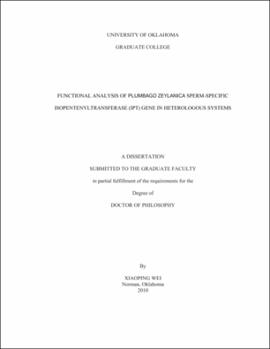| dc.description.abstract | Plumbago zeylanica is a unique model plant for the study of flowering plant heterospermy and preferential fertilization. During double fertilization, one sperm cell, which is physically associated with the vegetative nucleus (Svn) and possesses more mitochondria, will fuse with central cell to form endosperm. Whereas, the other sperm cell (Sua), which is unassociated with the vegetative nucleus and is rich in plastids, will fuse with the egg to form zygote. In order to determine whether gene expression differences in the two sperm cells of Plumbago zeylanica relate to their fertilization fate, populations of Sua and Svn sperm cells were isolated from mature pollen and representative cDNA libraries were constructed. We also employed the suppression subtractive hybridization (SSH) and cDNA microarray to identify cell type-specific genes in each sperm type. Among the differentiatially expressed transcripts, one group of ESTs which are highly up-regulated in Svn seems to encode isopentenyltransferase (IPT). We obtained the full length cDNA and promoter sequence of the Plumbago zeylanica IPT gene, named PzIPT1. Expression analysis of PzIPT1 using pollen whole mount In situ hybridization, semi-quantitative and quantitative RT-PCR showed that PzIPT1 was highly expressed in Svn, but much lowly expressed in Sua and pollen. We further characterized the gene's function in Arabidopsis and tobacco. To examine the expression specificity of the gene in cell/tissue types, we transformed Arabidopsis and tobacco with reporter genes of GFP and GUS driven by the PzIPT1 promoter. The pPzIPT1::GFP/GUS in Arabidopsis are predominantly expressed in the sperm cell and synergids. In tobacco, however, the reporter genes are expressed in the vegetative cells of pollen and ovule. In transgenic Arabidopsis, the reporter genes are also detected in vegetative tissues including maturation zone of root, leaf of young seedling, tip of mature rosette leaf and cauline leaf. The expression pattern of pPzIPT1::GFP/GUS is different from those of nine Arabidopsis IPTs promoter::GUS, suggesting that PzIPT1 is functionally different from known vegetative expressed IPTs. Overexpression of PzIPT1 driven by AtIPT3 promoter can restore Arabidopsis AtIPT3, 5, 7 knockout triple mutant atipt357 phenotype. Cytokinin oxidases (CKX) are enzymes that catalyze the irreversible degradation of N6-substituted purine cytokinins and can be used for cytokinin-deficient phenotype analysis. We used PzIPT1 promoter to drive AtCKX1 expression in Arabidopsis, and the transgenic plants showed reduced seed setting but otherwise were normal. The detailed cytological study showed that cytokinin deficiency is responsible for defects in both male and female gametogenesis. The plant with insufficient cytokinin has the first gametophytic mitosis blocked. The defective microspore and megaspore were arrested in uninucleate stage. These results suggest that PzIPT1 is a gametophyte-specific IPT and plays an important role in gametophytic cell division. We also showed that PzIPT1 paternal transcripts and proteins can be transmitted to the embryo sac and may initiate early cell division in endosperm and embryo development. | |
